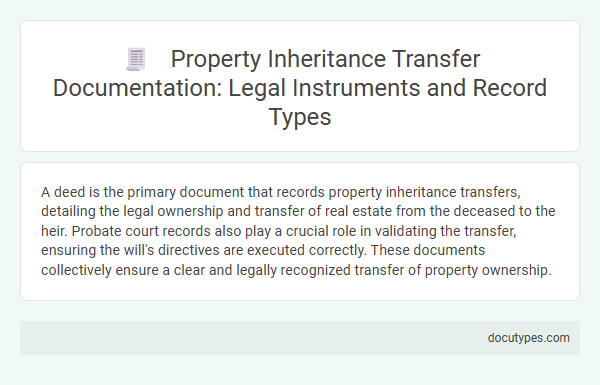A deed is the primary document that records property inheritance transfers, detailing the legal ownership and transfer of real estate from the deceased to the heir. Probate court records also play a crucial role in validating the transfer, ensuring the will's directives are executed correctly. These documents collectively ensure a clear and legally recognized transfer of property ownership.
Introduction to Property Inheritance Transfer Documentation
Property inheritance transfers require specific documentation to legally record the change of ownership. These documents ensure that the rightful heirs receive the property according to the deceased's wishes or state laws.
The primary document used in property inheritance transfers is the deed, often accompanied by a probate court order or an affidavit of inheritance. You must understand these records to ensure a smooth and official transfer process.
Key Legal Instruments for Inherited Property Transfer
Property inheritance transfers require specific legal documents to validate and record the change of ownership. Understanding these key instruments ensures that your inherited property rights are properly secured and officially documented.
- Death Certificate - Official proof of the deceased's passing, necessary to initiate the inheritance process and validate transfer claims.
- Will or Testament - A legal document outlining the deceased's wishes regarding property distribution among heirs.
- Grant of Probate or Letters of Administration - Court-issued documents authorizing the executor or administrator to manage and transfer inherited property legally.
Types of Inheritance Deeds and Certificates
Inheritance property transfers are documented through specific legal instruments known as inheritance deeds and certificates. Common types include probate deeds, executor's deeds, and inheritance certificates, each serving to establish rightful ownership after the decedent's passing. These documents confirm the transfer of property rights from the deceased to the heirs, ensuring compliance with estate laws and preventing disputes.
Probate Process and Essential Documentation
Property inheritance transfers are primarily recorded through the probate process, which legally validates the deceased's will and authorizes the distribution of assets. Essential documentation includes the death certificate, the will or trust documents, and the probate court orders confirming the transfer of property ownership. These records ensure a clear and enforceable transfer of title to heirs or beneficiaries, protecting their rights and preventing disputes.
Succession Certificates: Purpose and Requirements
Succession certificates are vital legal documents that record the transfer of property inheritance. They ensure rightful ownership and protect heirs from disputes or claims by unauthorized parties.
- Purpose - Succession certificates certify the legal heirs' right to inherit debts and securities from the deceased.
- Requirement - You must apply for a succession certificate in a civil court by submitting the death certificate and proof of your relationship with the deceased.
- Validity - The certificate remains valid until the estate is fully distributed, preventing wrongful claims during the inheritance process.
Title Transfer Procedures for Inherited Properties
Property inheritance transfers require specific documents to legally record the change of ownership. Understanding the title transfer procedures ensures your inherited property is properly registered.
- Death Certificate - Official document confirming the property owner's passing, essential for initiating the transfer process.
- Probate Court Order - Legal authorization from the court validating the distribution of the deceased's estate, including the property.
- Title Deed - Updated document reflecting the new owner(s) of the inherited property after the transfer is completed.
Following these procedures guarantees the lawful recording of property inheritance transfers in public records.
Record Types Maintained by Land Registries
Land registries maintain several crucial document types that record property inheritance transfers. These records provide legal evidence of property ownership changes following a person's death.
Common document types include probate records, which authenticate the distribution of the deceased's estate. You will also find title deeds updated to reflect new ownership through inheritance.
Required Affidavits and Supporting Documents
Property inheritance transfers are generally recorded through a Deed of Distribution or a Probate Deed. These documents officially transfer the title of inherited property to the rightful heir.
Required affidavits often include an Affidavit of Heirship or a Small Estate Affidavit, depending on the jurisdiction. Supporting documents such as the original will, death certificate of the decedent, and court-issued Letters Testamentary or Letters of Administration may also be necessary. You must ensure all paperwork is accurately completed to avoid delays in recording the transfer.
Ensuring Validity: Due Diligence in Documentation
What type of document records property inheritance transfers? A deed of transfer or an inheritance deed typically records the transfer of property ownership to heirs. Ensuring validity requires thorough due diligence in verifying these documents for authenticity and legal compliance.
What Type of Document Records Property Inheritance Transfers? Infographic

